Ellie’s Concert
Second grade, but first rate. And, prior to the the concert a little time helping out with the boys.
A little dancing
And some narrataion
Ben
James
Both
Second grade, but first rate. And, prior to the the concert a little time helping out with the boys.

A little dancing

And some narrataion

Ben

James

Both
In other words, lunch with Sally and Glenn and the twins. And on top of that, Renee dressed the boys in identical outfits, just adding to the merriment.


Cloudy, with a cold north wind. Pax and I decided to do a bike/run late in the afternoon and I was about froze solid by the time we made it back home.
...snow loses. The March sun is quite high in the sky and hanging around for a long time. Bad news for snow. Heavy shoveling this morning, but much of last night's accumulation already melted away.

Above is woodpecker shrapnel, chipped out of a sickly maple, just since the snowfall.
In-house projects today, mostly, although conditions outside were pleasant and the walking was not bad.
What wild weather! Pax and I had to choose our paths carefully today to avoid the worst of the cold and violent blast. And now there's snow, creating blizzard-like conditions.
As I look out at the back patio right now I see a small rabbit under the bird feeder, using his head as a shovel to get down to the spilled seed. He seems impervious to the weather.
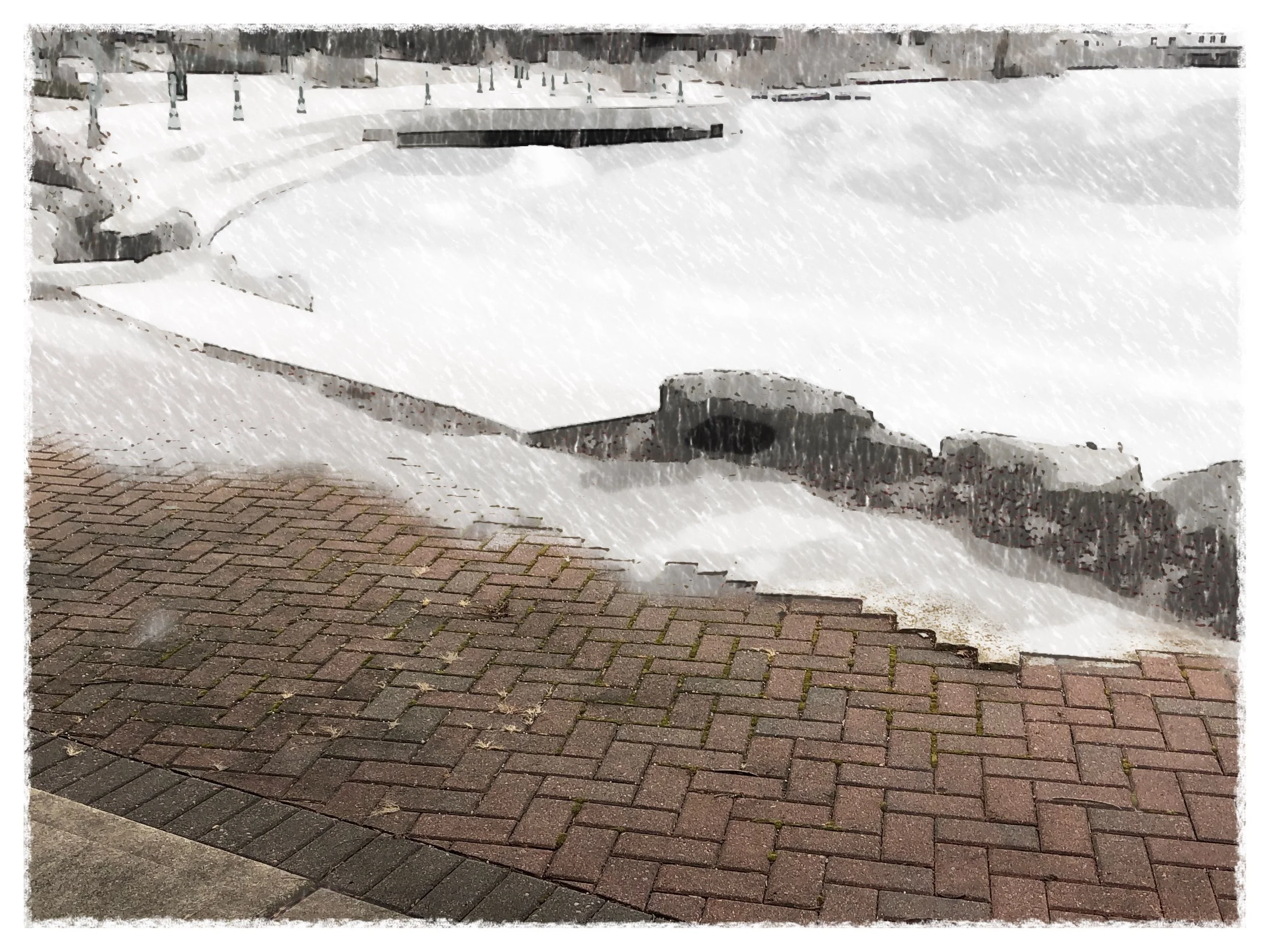
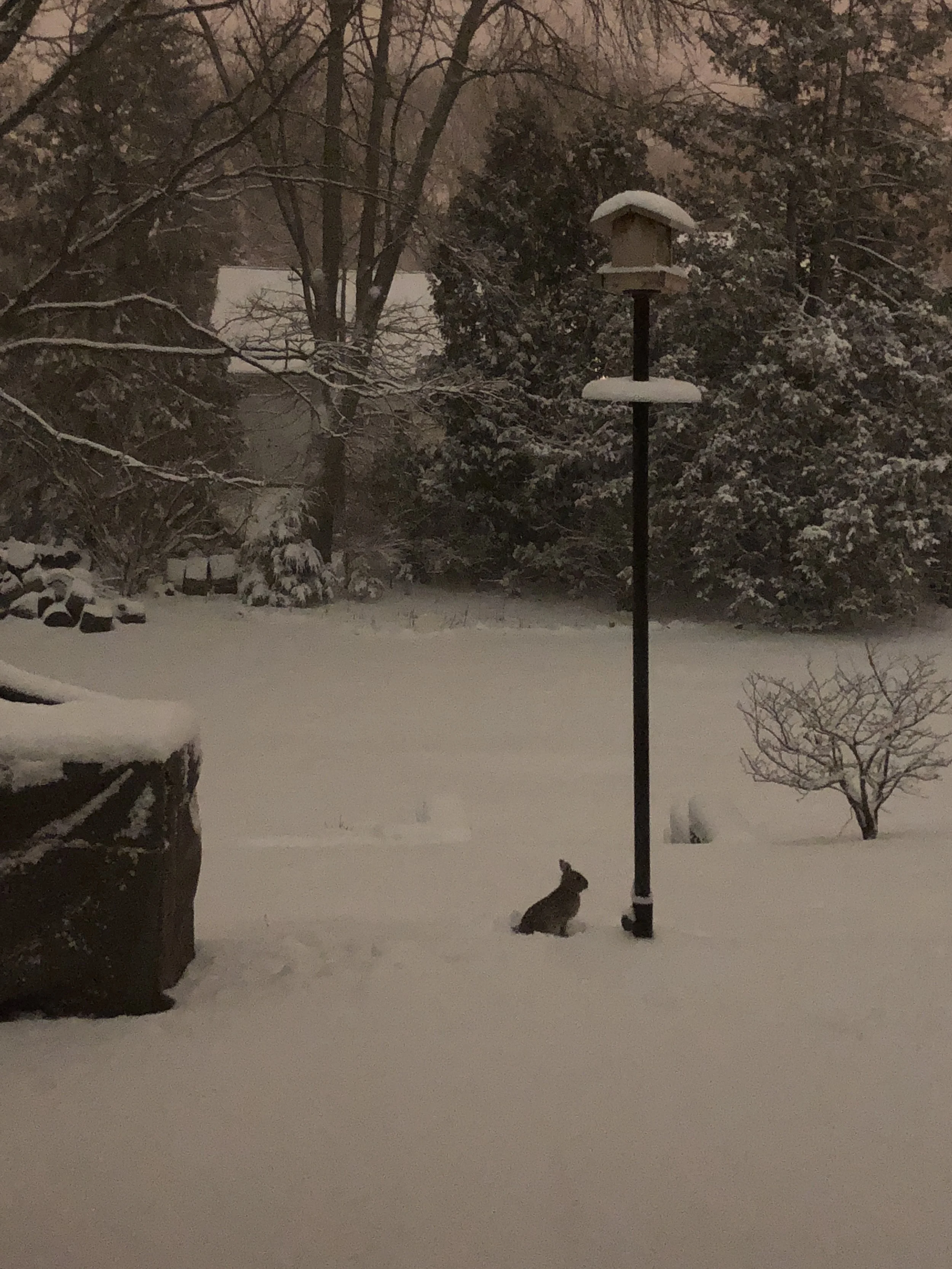
Photo by Sue
It being the end of the iceboat season, I decided to dig out and slightly update an old writeup of the sport:
~~~~~~~~~~~~~~~~~~~~~~~~~~~~~~~~~~~~
Three of us iceboat sailors were standing in a line, looking out across the lake, to some other race being held by a different class of boat. Quite suddenly, the skipper standing next to me disappeared. We three had been standing along the edge of an ice seam, where some areas can be weaker than others. Taking a step back from the seam, the two of us still standing on either side of our departed friend quickly reached down and pulled him out of the drink.
A quick transition like this from hard water to soft water is just one of the many perils of iceboating. I remember once watching a relatively new boater sail off the edge of the ice. The ice was hard and black, and this guy didn’t notice the difference between it and open water. Since iceboats don’t have brakes, a hard swerve was the best he could manage. Luckily for him, and for those of us who would have had to rescue him, his swerve was enough to keep the boat hooked on the ice by a single runner blade, and the skipper was able to climb, rather than swim, out of the boat.
Another friend of mine, an experienced sailor and successful racer, sailed into a different watery hole twice in the same afternoon. That particular hole was full of slush and thus hard to identify. But why he fell in the second time remains a topic for discussion.
There are actually very few injuries in the sport of iceboating. I once heard about a big boat that got away from its owner, sailed off on its own, and eventually ran over a fisherman, causing considerable damage. A non-iceboating friend once joined me on the ice to observe the sport, and, thanks to my negligence in not providing him with creepers, slipped and shattered his arm. I once watched a skilled sailor fail to react quickly enough to a sharp gust and tip his Nite-class boat up on its side, breaking his mast and cracking a few of his own ribs. Another skilled racing friend once destroyed both his own DN-class boat and a competitor’s by failing to avoid contact between the two, although somehow serious injury was avoided.
Of course, it would be wrong to give the impression that iceboating is nothing but disaster. It’s actually fun some of the time, and there exists a hard-core hard-water group that likes nothing better. One acquaintance has a car sporting a license plate that reads: “I Iceboat.” He lives in a village that bills itself as “The Iceboat Capital of the World.”
Putting things in perspective, there’s an old saying that iceboating is 75% tinkering, 10% bragging, and 15% waiting around for the right conditions. In other words, it’s the world’s most frustrating sport—it requires the simultaneous alignment of four impossible things: ice, an absence of snow, a temperature above 10 degrees F, and sufficient but not life-threatening wind.
Occasionally the stars do align, and then there is nothing like it.
A few years back, an early hard freeze on Crystal Lake left the lake a sheet of two-inch-thick window pane glazing. The ice was too thin to sail on, but because Crystal Lake has a wide shelf extending quite a way out from shore to the drop-off, we did so anyway, staying in the shallows, with the ice flexing dramatically under the boat as it slid almost silently along. We were able to watch fish swim by below, and when we found a muskrat under the glass we were able to follow him all the way back to his den. We did break through once…but the water was only knee deep, and everyone survived.
Sometimes when the whole lake was frozen but free of snow, we would adapt water skiing to hard water conditions, hooking up a tow-rope to the boat and having the kids put on their skates. Since slow in an iceboat is actually fast, when we’d crack the whip, the skier could let go and slide to the far horizon.
Cruising in traditional sailboats is an activity enjoyed by many, and cruising in an iceboat is also a possibility. It can be pleasant given the right conditions, but it is almost never practiced. For all intents and purposes, iceboating is all about racing, which, really, is the only way to tell if you know how to sail.
When racing, a course is set up using two marks, orange nylon pylons, set a mile or more apart along an imaginary line that represents the direction of the wind, with the windward mark directly upwind of the leeward mark. To start, the boats line up behind the leeward mark along a line perpendicular to the course. Skippers stand beside their boats, and when the flag drops, they push them ahead in a sprint, then hop in and trim the sail as quickly and smoothly as possible. From that point on it’s intense concentration mixed with intense exertion for two or three or four laps—many a hard and fast mile to the finish line.
The objective in a race is to make the boat go fast, both upwind and down. To do that the skipper has to find the perfect combination of speed, or footing; and up-course movement, or pointing. He has to play the puffs and take advantage of every wind shift. He has to be aware of all the boats around him, and adhere without fail to the somewhat arcane racing rules. He has to tack at precisely the right time (sailboats cannot go straight up wind), making sure to hit the lay-line and thus not overstand the mark or have to pinch up to get around it.
Rounding the windward mark is something else. The skipper needs to round it at the highest possible speed, preferably hiked up on two runners so that she is sling-shotted down course to the leeward mark. The G-force when rounding the windward mark can be large enough to inhibit breathing (at least temporarily).
Once at the leeward mark (sometimes without the chance to breathe a sigh of relief) she has to make a perfect turn, a smooth turn, rounding the mark without sliding sideways or spinning out, and then, once again quickly pointing as high as up wind as possible, with the sail sheeted in hard.
And all this while lying back almost flat and wearing an assortment of obstructive cold weather gear (balaclava, goggles, helmet, mittens, windproof coat and pants , spiked shoes, etc.) and going 40 or 50 or 60, or more, miles per hour.
Once I’m in the boat and have it moving well on the first upwind leg, I enjoy racing. Everything else in the world drops away and there is nothing but the present. Speed, wind, ice conditions, wind shifts, lay lines, sail trim, the other boats (especially those on starboard tack) all require a significant amount of attention.
Up to now, in spite of obstacles, and over quite a number of races, I have avoided collisions and almost always made it round the marks. One weekend some years ago I actually sailed so many races that by the last one my neck was shot— I could not, try as I might, lift it off the back deck, and I went around the course observing considerably more sky than race course.
Just to be clear, I have won some races. Quite a few, actually, I think, though I can’t remember precisely how many.
Having won races in the past, I sometimes wonder why I’m not driven to win more in the future.
Perhaps because I’m confident that I know how to sail an iceboat, and to make it go fast? Perhaps because I think I don’t need to keep proving myself to myself—or to anyone else for that matter? Perhaps.
So am I done with racing?
Well, maybe not. A day spent out on a lake in sun and wind and cold is a glorious day. There is actually something more than excitement—a sort of wild delight, at sailing four or five inches above the ice, going four or five times faster than the wind. And there’s always the thrill of, perhaps, winning yet another race.
The thing is, when you have an iceboat you are slave to a strange compulsion. As water freezes your freedom of choice diminishes. When conditions are right for iceboating you absolutely must forget everything else. Not taking advantage of something as rare and unlikely as a combination of good wind, good ice, and good competition, is like closing your eyes to a rainbow or giving up all food but tofu.
That’s why when the calendar works itself around to the middle of March I feel a certain relief. My thoughts then can turn to gardening and bike riding, and to getting soft water craft out of dry-dock and ready for launch.
Of course come October I’ll be hoping for a nice hard freeze well before Christmas.
A fun end to the season right at the last of the ice.

Checking the scores.
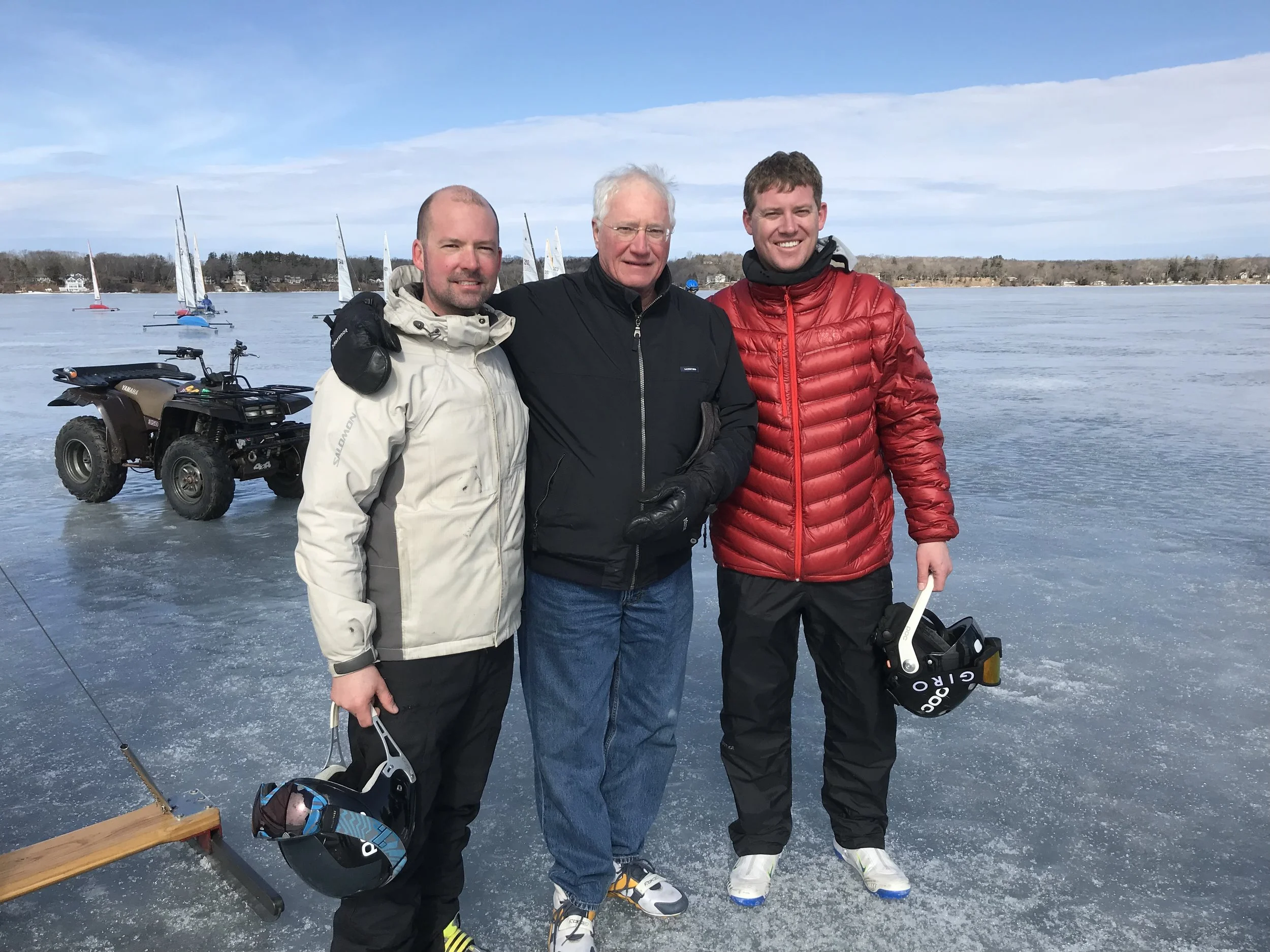
Fast company.
Bri finished 7th out of 23, just a point and a half out of 5th. Tony had some good races today, but couldn't make up enough ground to get hardware.
...out on the ice. Fluky wind and rapidly softening ice.
Bri is right at the top of the gold fleet—in first place for 5 legs of one race before the wind failed and the gluey ice grabbed him for an instant. Screen shots below the photos. The Nies name seems to be one to be reckoned with.

Registration

Note the number on the block. But for one slight bobble it would have been 3 higher.



When it comes to iceboating you never know. Supposedly the second running of the Nite Nationals will be held tomorrow. Will there be wind? Will the ice be hard enough? Will anyone show up?
Anyway, Nite #10 is set up and might do something tomorrow. Go Wombat.
Back in Whitewater this afternoon, the first robins. I'm not sure robins and racing should be in the same sentence.



Hard to believe.
Mostly cloudy with a cool north wind most of the day, but bright and beautiful before sunset. On our run/ride today Pax and I saw and heard Redwing Blackbirds, and Killdeer. Their arrival seems early, and I wonder what they're noshing on.

I see the moon...
The Nite National Regatta has been called on again (second attempt) for this weekend on Green Lake.
Twins, bike riding with the older kids, dinner, homework.


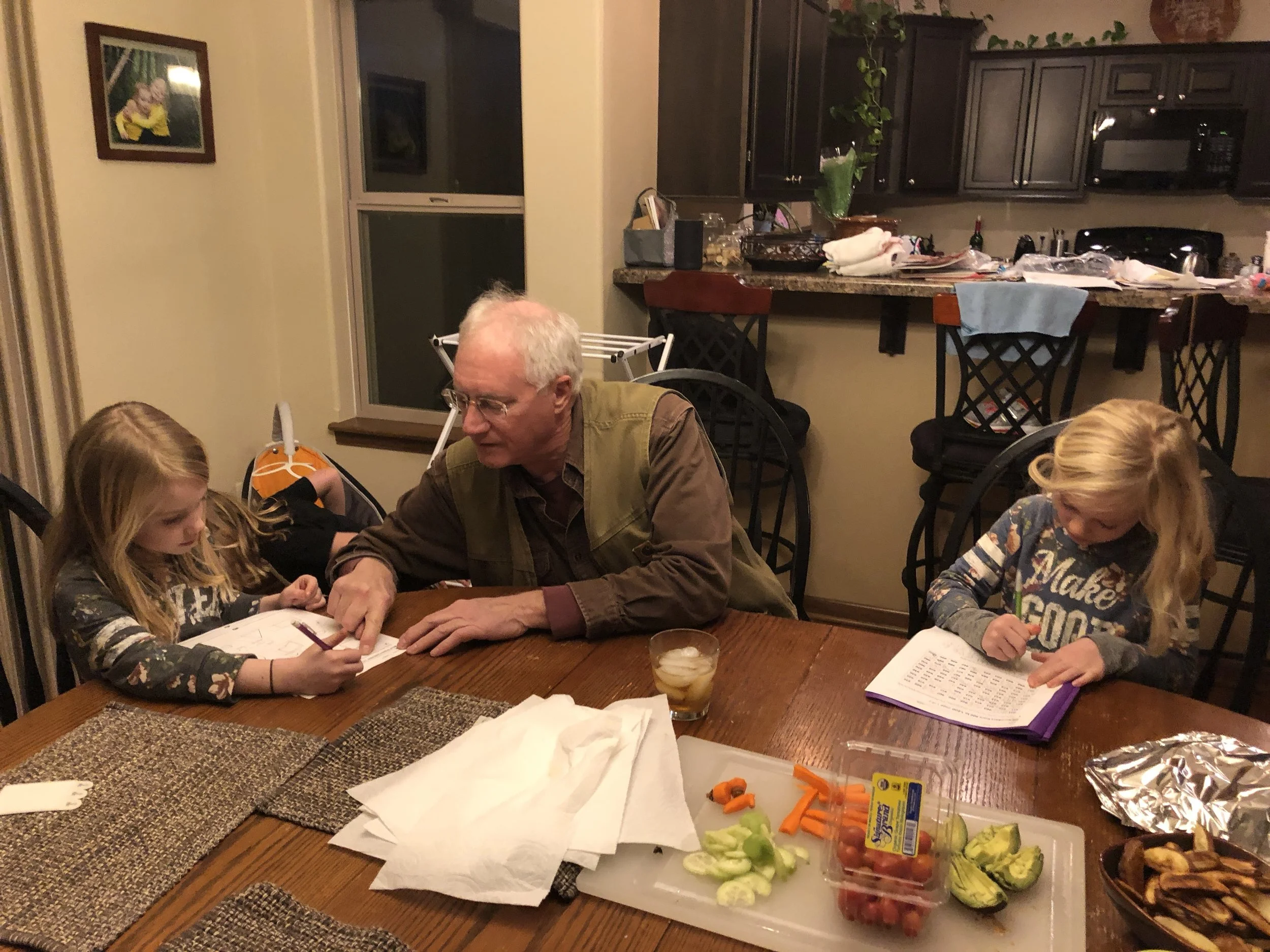
Several bellwether flocks, heading north.
Weather also good for biking, truck washing, and riding the motorcycle out to Emerson Esker.


High horns, low horns, silence, and finally a pandemonium of trumpets, rattles, croaks, and cries that almost shakes the bog with its nearness, but without yet disclosing whence it comes. At last a glint of sun reveals the approach of a great echelon of birds. On motionless wing they emerge from the lifting mists, sweep a final arc of sky, and settle in clangorous descending spirals to their feeding grounds. A new day has begun on the crane marsh.
Aldo Leopold
Up to 50.
Saw more dogs out being walked today than I've seen in the past three months. Do they all go south for the winter?

Very soggy at the prairie

Pax exploring, in his usual camoflage.

Ice around here not looking good.
I'm recommending the book Pianist in a Bordello, by Mike C. Erickson. Wacky, funny, but ultimately uplifting. (Recommended to me by Katriana.) Good anodyne for these trying times—it's about an honest politian.
Or late breakfast, rather. At our favorite place. Not an especially early start due to a late night previous.
A hint of spring. Very windy but very sunny, and a temp rising into the low 40s. Pax and I resumed our traditional prairie bike ride/run, though in abbreviated form.
And what about all the returning light? Over eleven hours of it now at this latitude.

Lunch, bike rides, and other good times with Katy and Will.



Chilly with wind off the lake. Rain this evening.

KWiL Publishing has this expectation that its authors have a website to which readers, fans, and others interested parties can refer—in support of published works. I tried to dodge the expectation, but too no avail.
The new site is a hodgepodge collection of odd bits of bric-a-brac, updated occasionally. Right now, there's not much there there, but I hope to add to it over time.
I have no idea where it will go or if it will last. Having no real idea of what it should be or how it should work, putting it together has been as stab in the dark.
Contributions are welcome—anything that would seem to fit the idea of paying attention, connecting to the natural world, thinking about things.
Here's the link: IntoNaturalWorld.org
Pax and I attempted walking the prairie today (Sue south on family business). Some squish and some slip, and some paths blocked by mud or ice, but we covered a good bit of ground. And there was this hawk— working the recently snow-free tall-grass.
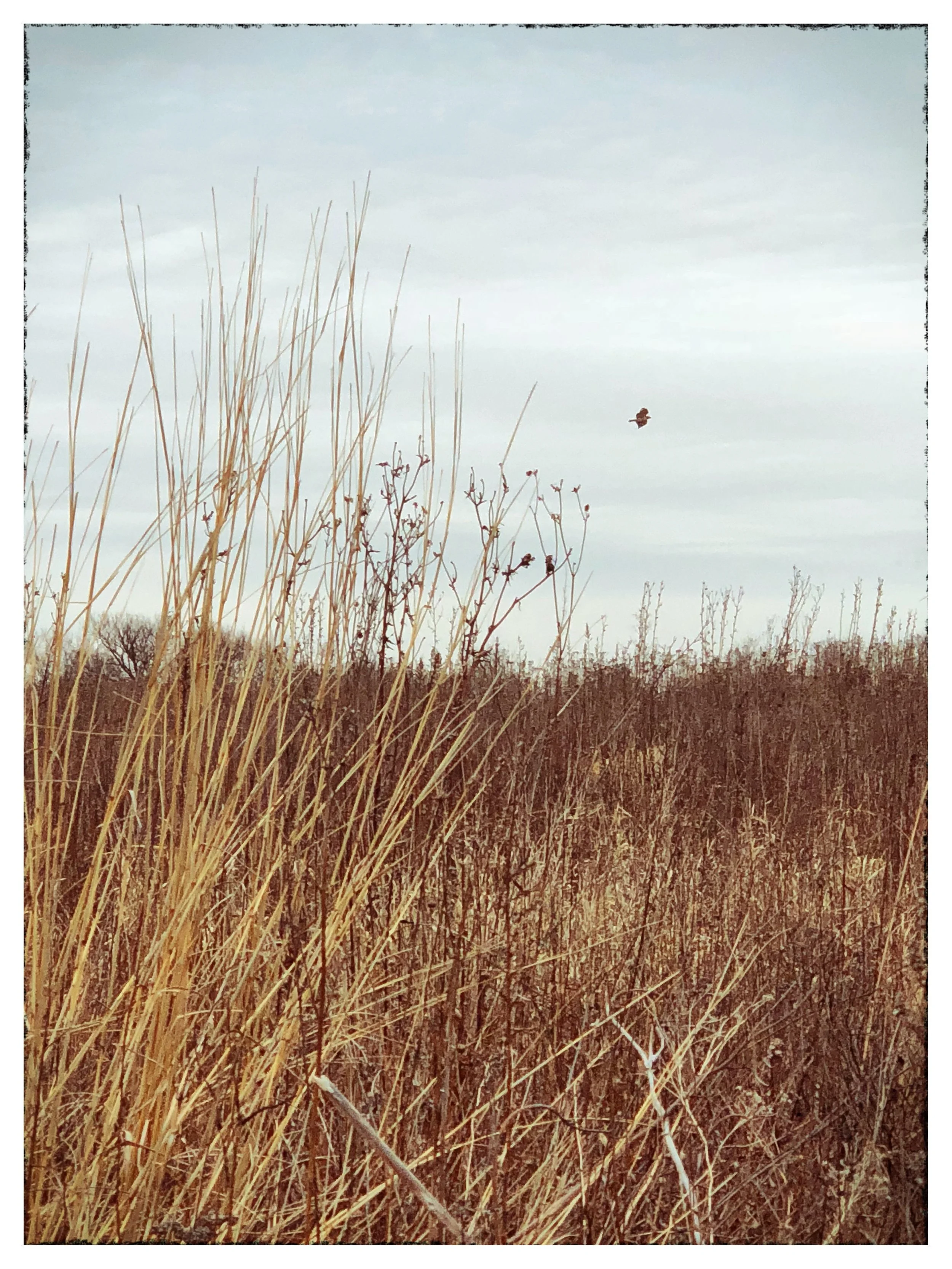
...and walking treacherous.

Reading Steven Pinker's new book—Enlightenment Now: The Case for Reason, Science, Humanism, and Progress—figuring I needed a bit of up to counter all the down swirling around at present. Here's a quote from the intro, a response to a question from a university student:
In the very act of asking that question, you are seeking reasons for your convictions, and so you are committed to reason as the means to discover and justify what is important to you. And there are so many reasons to live! As a sentient being, you have the potential to flourish. You can refine your faculty of reason itself by learning and debating. You can seek explanations of the natural world through science, and insight into the human condition through the arts and humanities. You can make the most of your capacity for pleasure and satisfaction, which allowed your ancestors to thrive and thereby allowed you to exist. You can appreciate the beauty and richness of the natural and cultural world. As the heir to billions of years of life perpetuating itself, you can perpetuate life in turn. You have been endowed with a sense of sympathy—the ability to like, love, respect, help, and show kindness—and you can enjoy the gift of mutual benevolence with friends, family, and colleagues. And because reason tells you that none of this is particular to you, you have the responsibility to provide to others what you expect for yourself. You can foster the welfare of other sentient beings by enhancing life, health, knowledge, freedom, abundance, safety, beauty, and peace. History shows that when we sympathize with others and apply our ingenuity to improving the human condition, we can make progress in doing so, and you can help to continue that progress.
...can result in flooding.

Since neither Pax nor I had waders, our regular walk was blocked. We had to take an alternate route.

I know, Pax, but I'm not wearing boots.



The edge of ice visible here used to be the shoreline before flooding expanded the perimeter of our little in-town lake. I'm guessing the same expansion happened on most Wisconsin lakes, and that makes getting an iceboat on and off the ice a bit problematic.
Possibly three inches of rain in this storm. Lake Michigan/Huron could be high this spring.
...though the heavy stuff seems to be passing to the south and east. Still, the back yard is a big icy pond.
Actually watched a bit of the Olympics today, my favorite fast-action sport—curling. I find curling to be quite exciting, more so than half-pipe or moguls, and way more so than figure skating. It reminds me, somewhat, of soft-water sailboat racing in very light wind. Nothing much happens, but the tension is extreme.

Hard from the south bringing slowly warming air. Barometer beginning to drop.

Good walking conditions on campus. Sue did taxes (she actually doesn't mind it).
~~~~~~~~~~~~~~~~~~~~~~
Heres the text of the "Manitoulin Overview" for the Great Lakes Islands Coalition "Island Showcase."
This is Manitoulin
Manitoulin is the largest freshwater island in the world, with an area of 2,766 km2 (1,068 sq mi). It separates the larger part of Lake Huron to its south and west from Georgian Bay to its east and the North Channel to the north.
Manitoulin Island itself has 108 freshwater lakes, some of which have their own islands; in turn several of these "islands within islands" have their own ponds. Lake Manitou, at 104 km2 (40 sq mi), is the largest lake in a freshwater island in the world, and Treasure Island in Lake Mindemoya is the largest island in a lake on an island in a lake in the world.
Manitoulin has two incorporated towns, eight townships, and six First Nations. It is home to about 13,000 permanent residents—about 40% First Nation and 60% of European extraction. What sets Manitoulin apart from most other Canadian communities is the unique relationship, indeed partnership, that the two communities have.
The Island is also “home” to many seasonal residents.
Access to the Island is by the seasonally operating Chi-Cheemaun ferry, which runs between South Baymouth and the village of Tobermory on Ontario’s Bruce peninsula; the one-lane swing bridge at Little Current (which is open for 15 minutes every hour in season to allow boats to pass between Georgian Bay and Lake Huron’s North Channel); and by private plane to one of two airports.
Some say that Manitoulin operates in its own time zone—known as ‘Island time’—a simpler, slower pace, more in tune with the environment and the great spirit Manitou. It’s a place for hunting and fishing, bicycle and horseback riding, kayaking and sailing, forest walks and stargazing.
Woods and meadows, pastures and croplands, unique alvars, bays and beaches. Farmers’ markets, summer festivals, powwows. A hospital with two sites, 10 schools (among them two high schools), a variety of coffee shops and restaurants, and even two breweries.
Like the other Great Lakes islands, Manitoulin relies heavily on tourism, but also counts government services, the service industry, and agriculture among its top economic drivers.
Manitoulin Island is a geological wonderland, and home to a great variety of interesting and sometimes unique flora and fauna. Salmon and trout spawn on the Mindemoya, Kagawong and Manitou rivers. Lakes Manitou, Kagawong and Mindemoya are internationally known fishing destinations. Georgian Bay and Lake Huron’s North Channel, with their drinkably clear water, are consistently ranked as one of the finest cruising destinations in the world.
An adventuresome hiking trail winds steeply up the spine of the Niagara escarpment to the Cup and Saucer, the highest spot on Manitoulin Island. From there the horizon stretches in every direction, a panorama of hills, forest, and lake—all surrounded by a ring of bright water.
Well, just a little bit. Today was chilly, though not cold, with a little light snow this evening. The melt continued ever so slightly, and the ice on the lakes is beginning to reappear through snow. Rain and warmth forecast for later in the week, so we may yet iceboat again.

However, I did think of summer during the occasional odd moment, and thinking of summer made me think of Manitoulin, which is now participating the the new organization known as the Great Lakes Islands Coalition (GLIC)—membership open to any island in the five Great Lakes with a year-round population, however small. I will award a significant prize (something like Carl Castle's voice on your answering machine) to anyone who can name seven of them!
Anyway, one thing each island has been asked to do is contribute information and photos to what is known as the GLIC "Island Showcase." Guess who ended up having to write the Manitoulin overview?